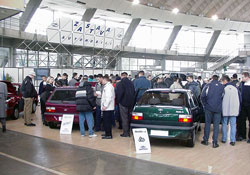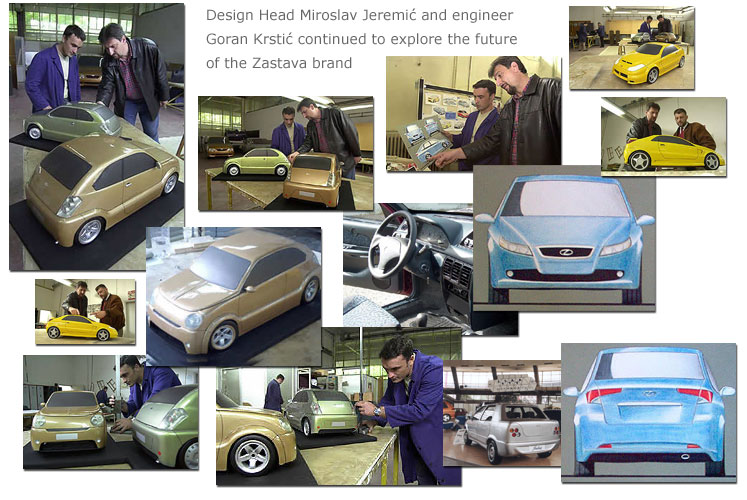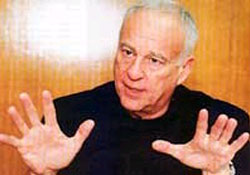
At the 2002 Belgrade International Motor Show, Zastava began taking orders for its new
Koral In and
Florida In models. Interest was high
The 41
st Belgrade International Auto Show in April 2002 is abuzz with excitement as Zastava rolls out its new
Koral In and
Florida In models. Working with Zastava's people in Kragujevac, France's Heuliez has done a commendable job of revising the line-up, while an agreement with PSA/ Peugeot-Citroen ensures that "In
L" variants meet Europe's
Euro 3 emissions standards.
PSA/ Peugeot-Citroen, Europe's second-largest automaker, will sell 5,000 engines per year to Zastava Automobili in the first phase of the agreement.
Announcing that Zastava exports to Croatia; Macedonia, and Egypt have begun again, Zastava Automobili director Miodrag Savičević speaks of
"strategic consolidation." "We have stopped the bleeding," he affirms.
"The process has been difficult, but we are now at the start of a new era - though still very much on our own."
The new engines have resulted in 123 changes made to the Koral In L; 120 to the Florida In L. To enable their production, Zastava is purchasing 32 components from PSA, and another 10 - including sensors and newer catalytic convertors - from various foreign suppliers.
While orders are taken for the Koral In/ In L and Florida In/ In L, Zastava has a few surprises in store. The company shows three concepts: a new subcompact; a new Florida sedan, and a Florida wagon.
On the basis of the Koral came a subcompact concept at a projected price of about 4,000 euros. Available engines were a 65-75hp injected 1.3-liter unit, and a 75-95hp injected 1.4-liter.
The Florida sedan concept used the existing car's roof; floorpan, and doors, but successfully reinvented its look, in the mold of the
'60s Tristać. A new dashboard featured, while the steering-wheel and front seats were height-adjustable. A price of 6,000 euros was bandied about.
The Florida Caravan wagon concept was 4.24 meters long, with a 760-liter boot, expandable to 1,530 liters upon folding the rear seats. Riding on a lowered front suspension, it wore 14-inch wheels shod with 175/60 tires.
Had the government's promised cash infusion come through, the new models would have begun the launch process, joined by a fourth made in Sombor, by Zastava Commercial Vehicles
(Zastava Specijalni Automobili): something similar to the Peugeot Partner; priced at 6,000 euros; built on the basis of the Florida Poly pick-up, and using the same engines as the Koral Concept.
Failing the investment, the proposals remained stillborn, although Zastava's design studio continued to work, showing what was possible.
It seems instructive to note that a full year before the Fiat Trepiuno concept which would become the 2008 Fiat 500, Zastava was devloping a successor to the famed Zastava 750, the Fiat 600D-based city car of the
'50s. There was a coupé, too, as Design Head Miroslav Jeremić and engineer Goran Krstić continued to explore the future of the Zastava brand.

Full of promise, 2002 proves to be Zastava's most successful year in a long time. The company even attracts the attention of the Yugo's original U.S. importer, Malcolm Bricklin.

Malcolm Bricklin announced that he would again import Zastava automobiles to the United States
Meeting with Serbian government and Zastava representatives in the Fall, Bricklin, 63, announces that he will begin importing ZMW (Zastava Motor Works) cars to the U.S. through his New Jersey-based NUCARCO group, starting in Fall 2003. The vehicles will sell for between $5,000 and $9,000.
The lowest-priced cars sold in the U.S. are Daewoo's Lanos ($9,694); Hyundai's Accent ($9,494); Kia's Rio ($9,590), and Toyota's Echo ($10,480). General Motors' Chevrolet Cavalier also falls into that range, with a base price of $14,400 and an available $3,000 rebate. The average price of a new car is $26,670, while used cars (according to NADA) sell for an average of $13,542.
Per Privatization Minister Aleksandar Vlahović, NUCARCO agrees to invest at least $150 million over three years. The ZMW joint venture, backed by a group of investors headed by Kaupthing Securities Inc. of New York, a unit of Iceland's Kaupthing Bank, plans to raise monthly production eightfold, to 10,000, over a period of three years. In five years, production could reach 220,000, a level not seen since the
'80s.
The number of employees involved in the venture is to grow from 4,500 to 9,000 over five years.
NUCARCO will own 80% of ZMW, while the Zastava Vehicles Group will take the remaining 20% stake, but will invest no cash; rather, Zastava will provide cars; land, and know-how.
Bricklin set up Subaru of America's distribution network in 1968. He left the company in 1971, nearly 20 years before Fuji Heavy Industries (which owns Subaru) acquired it. More than 120,000 Yugos sold in the U.S. before Bricklin sold out in 1988 for more than $15 million. Bricklin is also known for designing and financing production of the Bricklin SV-1, a gull-winged car similar to the DeLorean. He founded the Electric Bicycle Co. in 1995. Both ventures were unsuccessful, but certainly colorful.
"This will be the first time in the last decade that someone could go out and buy a new car with a new-car warranty for half the price of the lowest-priced car out there," Bricklin says, confidently predicting that the company could sell 60,000 cars in its first year. He proposes four different models: a two-door; a four-door; a convertible, and a pickup truck.
"Last time we did this, Yugoslavia was imploding, but now it's stabilizing. I'm willing to step out there and try things that other people aren't willing to do."
The deal is to be sealed on March 1st, 2003.
In 2002, the Serbian government invested more than 1.5 billion dinars in Zastava. 780 million dinars was set aside for the severance pays of 2,000 workers, while another 730 million dinars went toward monthly pay for workers who chose to be on paid leave, as part of the newly-established
Zastava Employment and Training (ZZO) facility. 6,972 former employees would receive 45% of their wages while being retrained.
Zastava reported that its average monthly sales had reached a ten-year high of more than 1,240 vehicles in its local market. In September, Zastavas accounted for 60% of the vehicles sold in Serbia, up from 10% in early 2001. The company attributed its recovery to the implementation of the government's support program; to its new models; to new advertising, and to more favorable sales terms. Companies were attracted by interest-free financing (with a four-month grace period), and by a lengthened warranty.
This year, Kragujevac produced 11,100 cars, rather than the planned 18,000. While disappointing, the factory's output was nonetheless 48% higher than it had been in 2001.
2002's production was sold out before the year ended, and 1,200 cars were exported - also considerably less than the 6,000 planned, largely because not until October 2002 were the new Peugeot engines installed in any number.
7,000 exports were planned for
2003, part of a planned production of 25,000 vehicles.